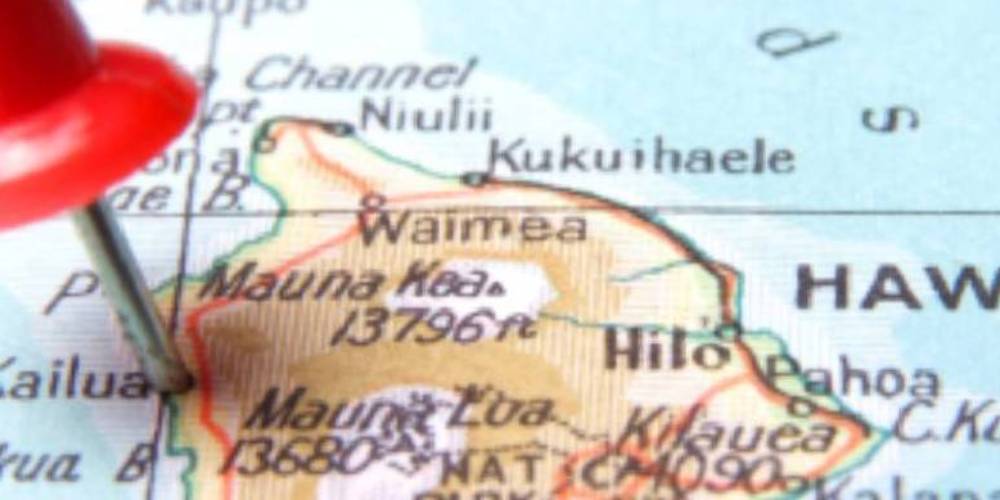The quintessential island paradise, Hawaii is home to many popular filming locations, a great deal of natural beauty, and a booming tourism industry. But, those who call it home will also recognize its amazingly diverse and unique native plant population. Due to Hawaii’s semi-isolated location in the Pacific and its volcanic origins, its plants and animals have been allowed to evolve in ways that differ greatly from those on the mainland and even other nearby islands. Therefore, Hawaii has much flora and fauna that you may not encounter anywhere else in the world. All in all, this island state is a true mecca for those interested in conservation and naturalism.
In this article, we will touch on some of Hawaii’s epic native plants, why they’re so important, and what you can do to help foster their populations in your own backyard! In addition, we will provide you with some crucial information on one of their biggest threats, invasive plants, and how you as a home gardener can mitigate their risk.
By the end, we hope you will find some native plants that spark your interest, find ways to grow them on your property, and ensure their protection in the wild. So, get reading and happy gardening!
The Importance of Native Plants
As a home gardener, you may have heard tell of native plants. You may know that they’re important, that their use is becoming more and more popular, or that they can strengthen an ecosystem. However, you may not know why they matter more than other plants, or just how beneficial they can be to your garden.
Well, wonder no more, for that’s why we’re here! We want to provide you with the information you need on native plants to help you make more informed, positive changes to your landscapes, so we’ll discuss just some of the benefits they can bring to you!
For starters, native plants are specific species that belong to a specific area or set of areas. They may cross state boundaries, travel across rivers, or even stay in very limited locales, but they all have evolved to grow and survive in their own special spots. Native plants across the country and world may have evolved to grow in the coldest, driest mountain ranges, or the muggiest, most stifling swamps. They may have evolved to grow along with a community of other plants and animals, only being found alongside their friends.
But, why are native plants so crucial to our world? Why is their prosperity so closely linked with our own? Native plants, when grown in their native habitats, provide boundless benefits, from feeding and sheltering native animals to building and stabilizing healthy soil structures. This all, in turn, helps foster the biodiversity of all living creatures, again, strengthening ecosystems and bringing balance to nature, which humans have undoubtedly harmed. During hurricanes and erosion events, native plants can block winds, prevent landslides, and limit flooding. After fires, native plants can colonize quickly, restoring life and bounty to the burnt remnants. They provide shade and lower temperatures, cleanse water sources and purify air. Not to mention, native plants add beauty to landscapes, creating a unique sense of place for your garden, rather than a carbon copy of one found in any garden magazine.
Native Plants of Hawaii
Of course, we can’t list out every single native plant found in Hawaii; there are thousands of unique species that call these islands home. Instead, we have listed out a few species from their respective categories, providing you with some of their characteristics and benefits to healthy habitats. Below, you will find information on native herbaceous perennials, shrubs, trees, and vines, followed by details on their rivals, invasive plants.
Perennials
O’ahu Wormwood (Artemisia australis)
As many species of the genus Artemisia, O’ahu wormwood can be recognized by its distinctive leaves, donning fuzzy, silver gray fur. When crushed, these leaves release a pleasant, herbal scent, making it a great choice for sensory gardens. Plus, its small yellow flowers, though understated, add just the perfect touch of color to the plant throughout the year.
Hawaiian Tree Fern (Cibotium menziesii)
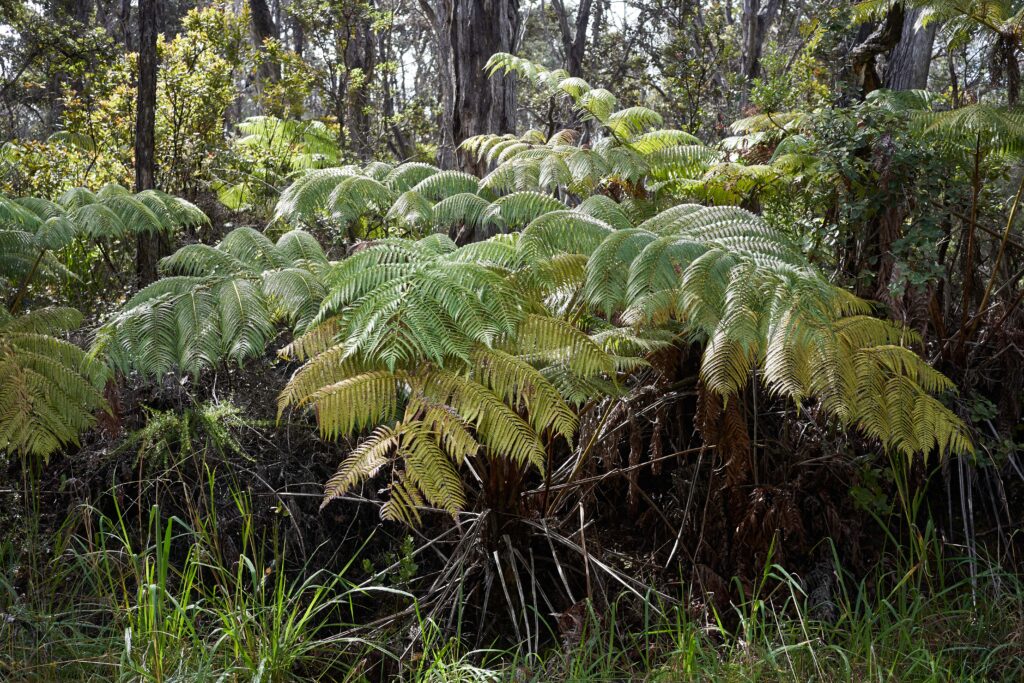
Also known as hapu’u, the Hawaiian tree fern is the largest species of tree fern endemic to the Hawaiian islands. Its fronds, which start off with thick, furry brown hairs, unfurl to reveal bright green leaves that reach heights of up to 35 feet tall! These ferns are quite unique, boasting the ability to grow in moist soils on the forest floor or on shrubs and trees above. Hapu’u is so large that it can certainly be mistaken for a palm tree if you’re not paying close attention. The key to remember with ferns is how their leaves reveal themselves, starting out as balls in the center of the plant, and opening up like a caterpillar into their full form. Ferns, along with cycads and mosses, are some of the world’s oldest living plant species! Make sure to cherish them and help them grow.
Sea Purslane (Sesuvium portulacastrum)
Found in moist, sandy soils, sea purslane is a great choice as a ground cover, pot-draper, and water feature border. Not to mention, due to its ability to spread quickly and its high salt tolerance, it’s also a fine choice for areas in need of erosion control, such as beaches or dunes. Recently, it has also been used to help bolster the endangered Laysan duck population, as it provides a great habitat and purifies heavy metals in water sources. Sea purslane’s succulent-esq leaves and small, pinkish flowers add just the perfect mix of plain and fun! In fact, like other members of the portulaca group, sea purslane is also edible. You may use its leaves in salads, fried up as a tasty veggie side dish, or simply as a garnish for plating.
Shrubs
Yellow Hibiscus (Hibiscus brackenridgei)
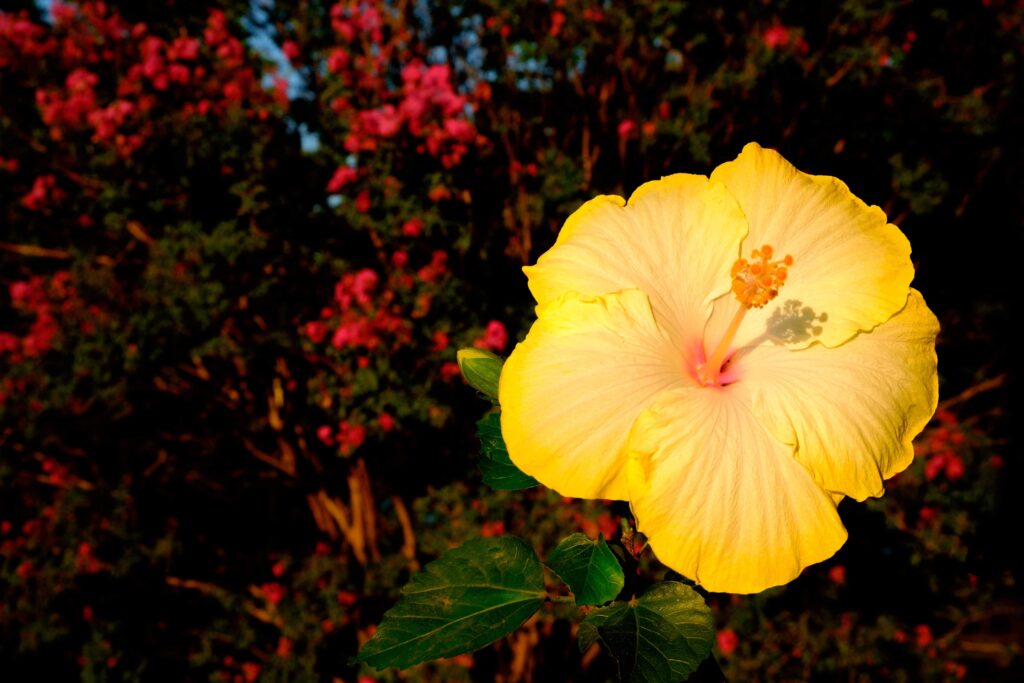
Known in Hawaiian as Ma‘o hau hele, the native yellow hibiscus flower is the official state bloom of Hawaii! Though grown in cooler regions as an annual or a houseplant, ma’o hau hele is actually a perennial shrub in Hawaii. It tends to enjoy dry, well drained soil with lots of light exposure. In the best conditions, this beautiful endemic species can grow over ten feet tall, brightening any space with bursts of happy yellow! Traditionally, these blooms have been used to make dye for clothes and other wares.
Ilima Papa (Sida fallax)
Native to Hawaii, various Pacific islands, and parts of China, ilima papa is an extremely variable plant. It can grow anywhere from five feet to ten feet tall and can be found in dry forests, moist forests, lava fields, sandy spots, reef edges, and basically any other landscape in Hawaii. Its leaves can be found with or without little hairs protruding from them. Its flowers can range from yellow to orange to red. Scientists actually suspect this plant may cover a variety of subspecies, though more research would be required to confirm these theories. Plus, the pretty flower of ilima papa, known as pua `ilima, is actually the official flower of the island of O’ahu.
Mokihana (Melicope anisata)
Native only to the island of Kaua’i, mokihana can grow as a shrub or occasionally, a small tree. You will typically find this native in moist forests at an elevation of up to 4,000 feet. Its seed is actually the official material for lei making in Kaua’i, making it a very important ceremonial as well as tourism resource. Plus, its bright red anthers, often mistaken for its flowers, are quite striking and beautiful, as well. Mokihana’s thick, leathery leaves are also impressive, giving off a strong, sweet scent of licorice when crushed!
Trees
Ohi’a Lehua (Metrosideros polymorpha)
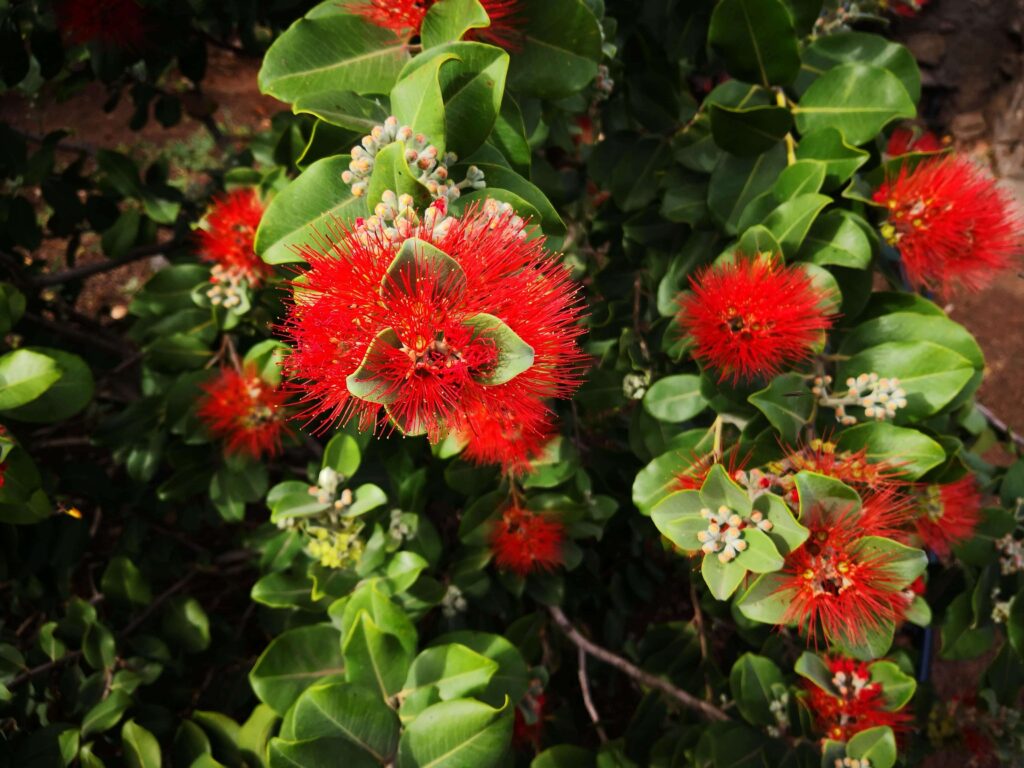
The most common native Hawaiian tree, ohi’a lehua can be found on all of the main islands of this polynesian state. It tends to be one of the first plants to occupy areas affected by lava flows, growing all the way up to 82 feet tall in the best conditions. The ohi’a lehua tree is very important to Hawaii, both for ecological and traditional purposes. In nature, this tree provides shelter and food for many passing animals, while also contributing to water conservation due to its root system. Traditionally, the ohi’a lehua tree has been used for a number of things. Its bark was used to make weapons and poi boards (wooden surfaces on which poi, the starchy food made from taro corms, was pounded into its popular, glutenous texture). Its leaves were used in teas to aid in medical issues. And, its flowers were, and still are, used to create beautiful leis and hula accessories for ceremonial purposes. Unfortunately, this common tree has had many enemies over the years, from wildfires and invasive plants to the most recent outbreaks of fungal diseases like Rapid Ohi’a Death.
Koa (Acacia koa)
The largest native tree found in Hawaii, the majestic koa can reach up to 115 feet tall in the best conditions. These conditions, including growth on higher elevations, may not always be met, however, so most koas used for landscape and garden purposes will only reach about 30 feet high. Long before Hawaii entered into the Union, these trees were considered the official wood-bearers for royalty, providing their bark to make a whole range of materials. Koa trees had been used to make canoes, weapons, and even ukuleles. Today, it is one of the most valuable and expensive trees in the world, and therefore, is always in need of protection.
Māmane (Sophora chrysophylla)
Māmane trees, bearing bright yellow blooms in spring and winter, can be found on most of the main Hawaiian islands. Aesthetically, its pea flower blooms and thick, green leaflets are quite beautiful to behold, but its importance extends far beyond just appealing appearances. The māmane – which is a part of the pea family – is an extremely important food source for the endangered palila, a yellow-headed honeycreeper bird. Its fruit and flowers are the main food source of this fading species, which can only be found in Hawaii. Unfortunately, climate change, including extended dry spells, and forest destruction have led to the downfall of this bird. It’s already extinct on some parts of Hawaii’s main island.
Vines
Native Dodder (Cuscuta sandwichiana)
A parasitic vining plant, this dodder, not to be confused with its invasive relative, is actually native to Hawaii. As it need not collect its own energy from the sun, native dodder does not have any chlorophyll-filled leaves. In fact, it doesn’t have leaves at all. Instead, its stems, which are yellow to orange in hue, blanket native plants, using root-like organs called haustoria to extract all the nutrients they require. Unfortunately, this can kill its host plants, but that doesn’t make it a “bad” plant. In fact, native dodder is used as the official lei making material on the island of Lana’i.
Ie’ie (Freycinetia arborea)
Acting like a vine, this native tree climber twirls and hangs its way around Hawaiian forests. With thick, woody stems, long pointy leaves, and sausage-like spike flowers, these plants are quite hard to miss. Traditionally, the ie’ie is extremely important to native Hawaiians, as its parts were used to make a range of weavable items, from fishing baskets and traps to statue-heads of the kiʻi akua hulu manu, or feather war gods. Ecologically, the native ie’ie is especially important for the survival of native snails, providing great shelter at the watery crevices of its leaf bases. Sadly, like many native plants, these are no stranger to population loss by forest destruction and invasive species competition.
Seabean (Mucuna gigantea)
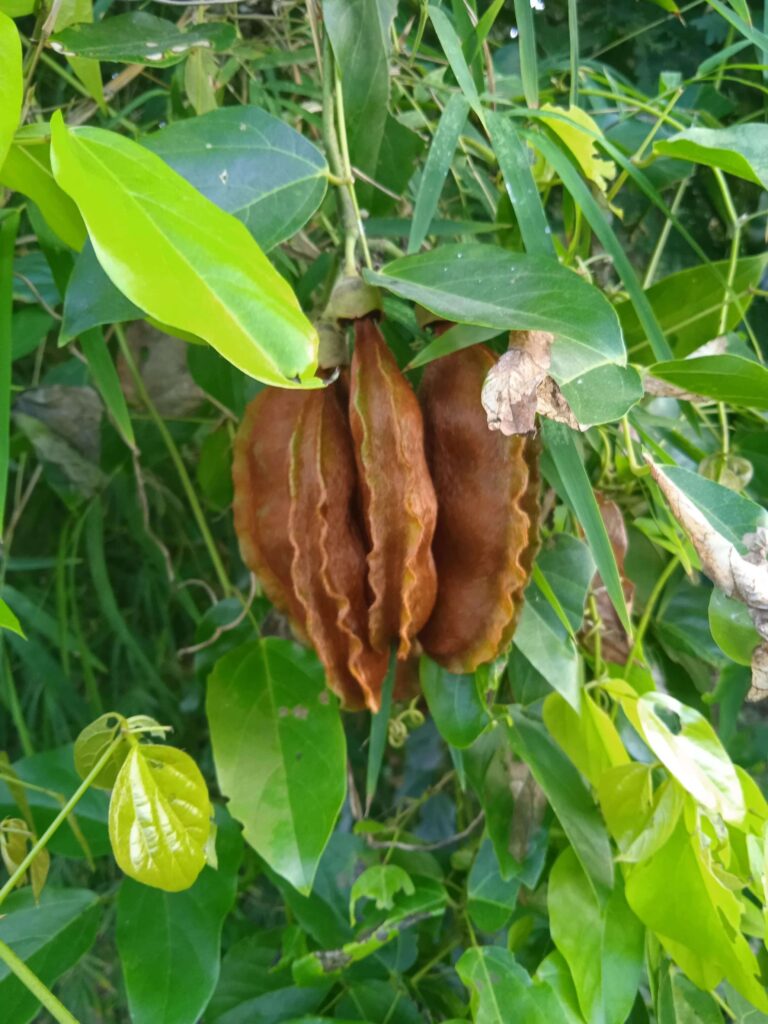
Another member of the pea family, the seabean is a very beautiful and interesting vining native. With glossy green leaves and hamburger-looking seeds, this plant enjoys living close to the coast at lower elevations. You may find it vining on trees, shrubs, or across the ground, but make sure not to eat its flat, brown seeds; though they can be used medicinally, they are toxic in large enough doses. Instead, you may use the hard, sea-faring beans to make leis or other aesthetic adornments.
Hawaii’s Invasives
Just like any other state, Hawaii has a huge issue with invasive plants. Although it’s located far from the mainland, invasives have made their way to this Polynesian paradise by way of water, wind, and mostly, humans. Though many non-native species, like Colocasia esculenta used to make poi, are very important to Hawaiian culture, some have reached the point of becoming threats to natives. Below, we have listed five of Hawaii’s most dangerous invasive species in hopes that you will remove them from and avoid using them in your landscape.
English Ivy (Hedera helix)
Though English ivy is an elegant and popular groundcover, it’s actually quite invasive in the United States. Native to Europe, parts of Asia, and North Africa, English ivy has become a long-term resident of American forests. There’s a good chance you have it in your own yard, as well, as it’s a mainstay of garden centers for its quick growth patterns and evergreen abilities. That being said, English ivy is one of the most detrimental invasives to forests, strangling large trees, covering canopies, and suffocating new tree, shrub, and herbaceous growth below. If you must keep English ivy in your garden, opt to bring it indoors; it can make a great houseplant!
Himalayan Blackberry (Rubus discolor)
A large bush reaching heights of up to 13 feet tall, Himalayan blackberry is not a bush to keep in your Hawaiian garden. Though it provides fruit for people as well as wild animals, this non-native bramble is a significant threat to Hawaii’s habitats. Sprawling across a variety of landscapes from harsh roadsides to wide open fields, the European native easily snuffs out the lives of its Hawaiian native neighbors. It can easily shade out herbaceous perennials, small shrubs, and tree saplings, as well as simply hogging too many resources, namely space. Plus, this invasive blackberry produces thousands of seeds per bush, each of which can remain viable in the soil for years, making it very difficult to eradicate.
Bingabing (Macaranga mappa)
A small, thin tree with large, taro-like leaves, bingabing is a relatively recent invasive species to Hawaii. Currently, it is only found on the islands of Hawai’i and O’ahu, but already, it has become a threat to native species. Interestingly, this Filipino native first made its way to the Hawaiian islands via airplanes. After fires erased large portions of greenery in Hilo, planes that flew overhead inadvertently dropped seeds into the freshly burned soils below, allowing them a nice new home to inhabit. Unfortunately, since then, bingabing trees have spread onto roadsides and forests, alike. And, due to their unique leaves and petal-less pink flowers, many residents have kept them as ornamentals, furthering their stronghold.
Madagascan Butterfly Bush (Buddleja madagascariensis)
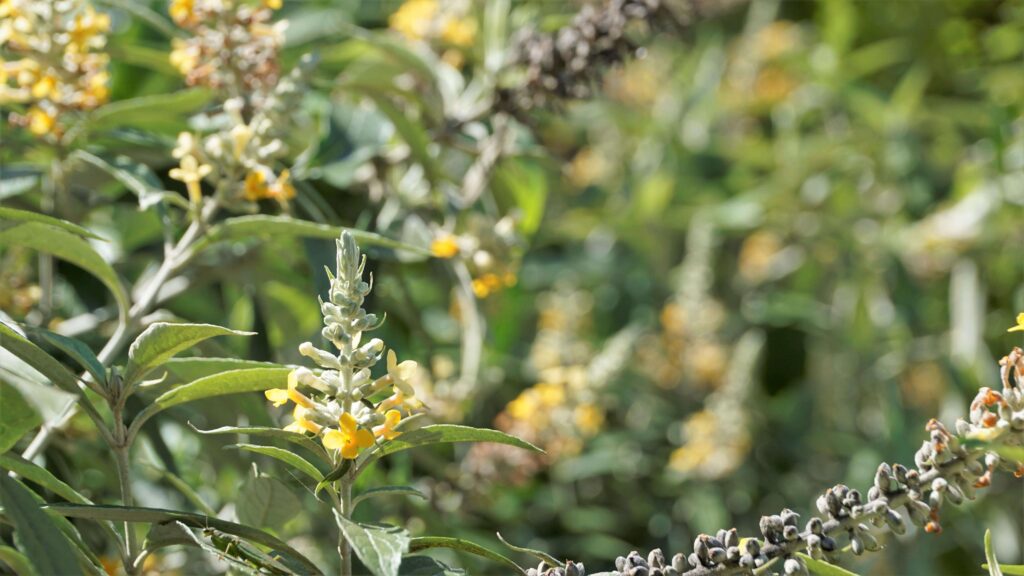
Also known colloquially as smokebush (though, not to be confused with the U.S. native smokebush or smoke tree, Cotinus coggygria), Madagascan butterfly bush is an extremely aggressive invasive shrub. Though its fragrant, skinny yellow and orange flowers may be attractive to pollinators and people alike, there are many native species that can get the job done, instead. This African native is especially dangerous as it emits a powdery substance that causes lung irritation, making it difficult to breathe if disturbed. Therefore, when removing this, be certain to take proper precautions.
Strawberry Guava (Psidium cattleianum)
Native to Brazil, strawberry guava is a highly invasive tree found on all of Hawaii’s main islands. Introduced as an ornamental in the 1800s, strawberry guava, also known as waiwi, is easily able to take over entire landscapes, turning diverse, multi-storied ecosystems into monoculture forests. As it produces edible fruit, strawberry guava trees attract loads of fruit flies, making the areas they take over into fruit fly infestations. Not to mention, they tend to create such moist, swampy conditions that mosquitoes will also inhabit their invaded homes.
5 Things You Can Do to Help Hawaii’s Native Plants

Hawaii native plants and trees face threats from climate change, habitat loss, and invasive species. Conservation efforts are underway to protect them. Initiatives include reforestation projects, the establishment of protected areas, and the promotion of sustainable harvesting practices.
But, as a home gardener, you may wonder how you can get involved, how you can help protect Hawaii native plant population. Well, don’t you worry, because we’ve compiled a list of 5 things you can do to help!
1. Bye bye, Invasive Plants!
As long as you have the right equipment – gloves, soil knives, and pruners – feel free to help the environment by getting rid of invasive plants like the ones listed above!
2. Hello, Native Plants!
Once you remove those pesky invasive plants from your landscape, why not replace them with helpful natives? Visit your local garden center for fully grown specimens or simply start off with seeds! Either way, by planting and caring for native plants, you’re surely doing your part to protect our natural world.
3. Welcome Home, Pollinators!
One surefire way to help native plants is to help their pollinators! Refrain from using harmful pesticides in the garden, as they will kill pests as well as pollinators. Plus, you could even purchase things like bee boxes or birdhouses to make pollinators and seed spreaders feel welcome in your space!
4. Natural Fertilizers!
Sometimes, you may want to give your native plants some extra love with fertilizers. However, there’s really no need to drench the earth with harsh chemicals to do so. Instead, try using natural fertilizers like liquid seaweed!
5. Get Involved!
Chances are, if you’re interested in helping out the environment in your neighborhood, others are, as well. So, check out your local parks departments, botanic gardens, and arboretums to see if they’re hosting any volunteer activities. You may find outings to remove invasives from parks, install natives in gardens, or care for city trees! But, of course, sometimes the most important place to start is your own backyard!
